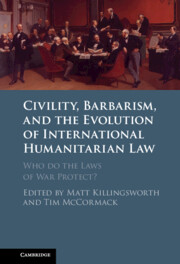 Civility, Barbarism and the Evolution of International Humanitarian Law
Civility, Barbarism and the Evolution of International Humanitarian Law Published online by Cambridge University Press: 11 January 2024
According to a well-established rule of the law of armed conflict, warring parties are prohibited from employing weapons, means, and methods of warfare of a nature to cause superfluous injury or unnecessary suffering. Agreement about the foundational nature of this rule can, however, easily conceal the disagreement as to its precise meaning and efficacy. This paper considers the origins of the rule in question, and how key aspects of the rule are interpreted. It then examines one of the more contentious issues about the rule, namely whether it is only concerned with the inherent properties of particular weapons or whether it also deals with the use of weapons generally.
To save this book to your Kindle, first ensure [email protected] is added to your Approved Personal Document E-mail List under your Personal Document Settings on the Manage Your Content and Devices page of your Amazon account. Then enter the ‘name’ part of your Kindle email address below. Find out more about saving to your Kindle.
Note you can select to save to either the @free.kindle.com or @kindle.com variations. ‘@free.kindle.com’ emails are free but can only be saved to your device when it is connected to wi-fi. ‘@kindle.com’ emails can be delivered even when you are not connected to wi-fi, but note that service fees apply.
Find out more about the Kindle Personal Document Service.
To save content items to your account, please confirm that you agree to abide by our usage policies. If this is the first time you use this feature, you will be asked to authorise Cambridge Core to connect with your account. Find out more about saving content to Dropbox.
To save content items to your account, please confirm that you agree to abide by our usage policies. If this is the first time you use this feature, you will be asked to authorise Cambridge Core to connect with your account. Find out more about saving content to Google Drive.